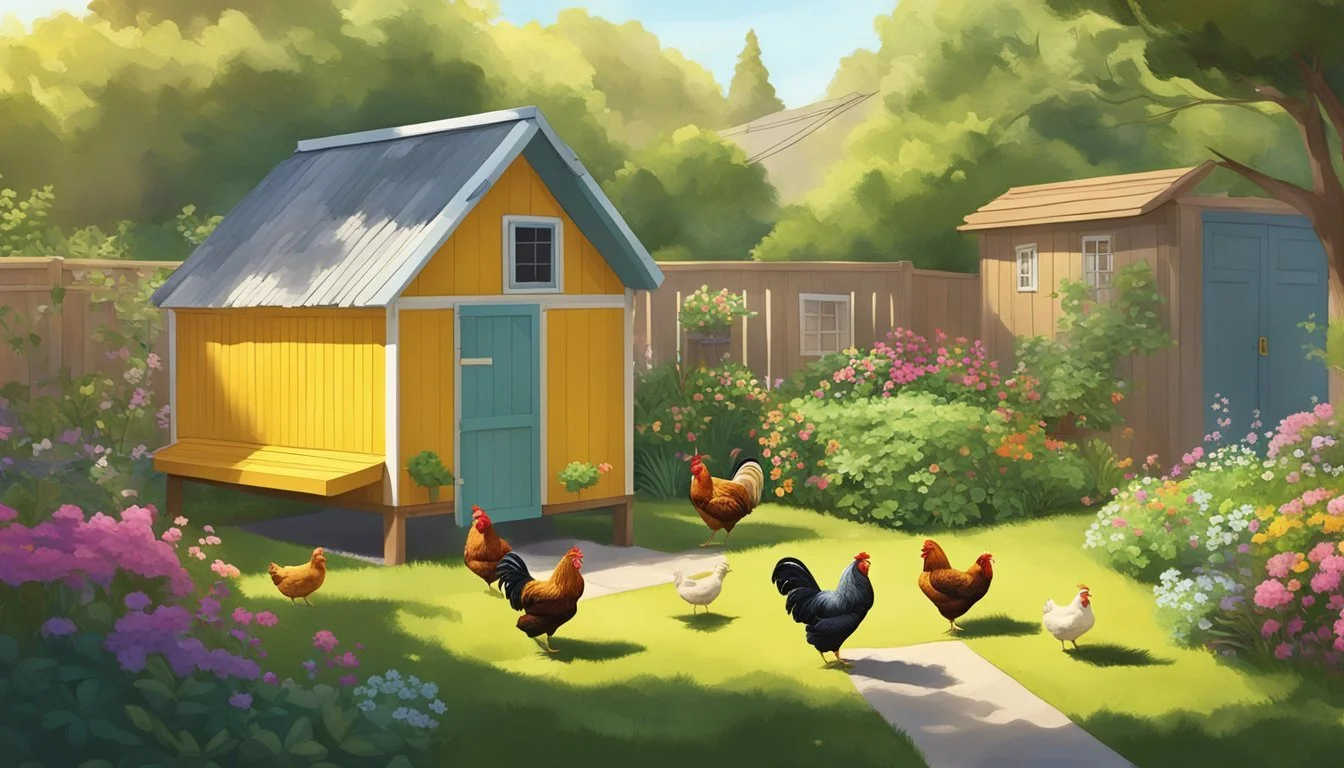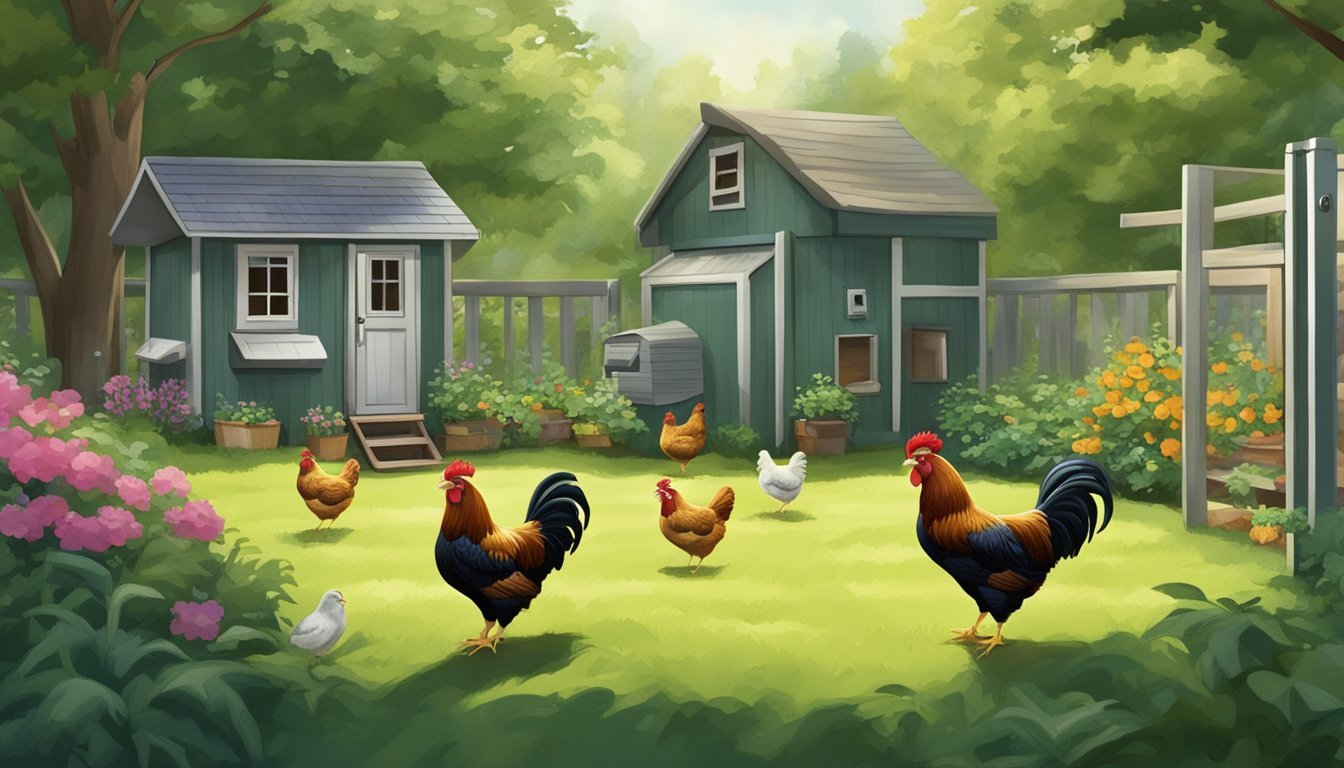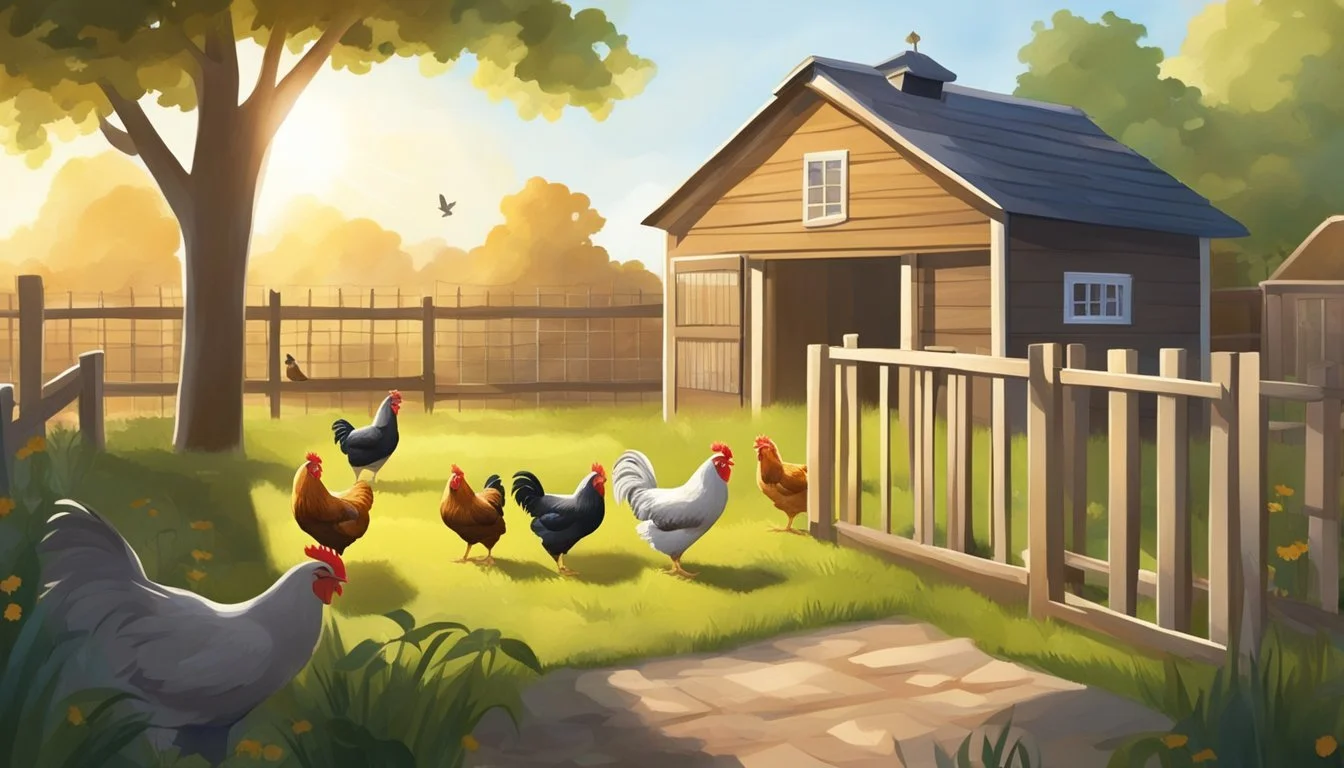Raising Backyard Chickens in Alameda, CA
Essential Tips for Urban Poultry Farming
Raising backyard chickens has become an increasingly popular endeavor in Alameda, California, reflecting a broader trend towards local food production and sustainable living. Residents of Alameda interested in keeping chickens must adhere to specific county regulations, ensuring that their poultry-keeping practices are safe and considerate of their neighbors. Regulations include a requirement for permits for all chickens, a minimum of 200 square feet of yard space per chicken, and a considerable distance, typically 40 feet, from the chicken coop to any neighboring dwelling. An inspection by Alameda County Animal Control is also a necessary step to sign off on the required permit.
The culture of backyard chicken raising in Alameda is supported by robust community networks and resources. Local groups such as Alameda Backyard Chickens offer a platform for residents to share tips, coordinate supply runs, and even participate in events like the Alameda Chicken Coop Tour. Stores within Alameda and the surrounding East Bay area provide essentials for poultry care, including chicken feed, supplies, and baby chicks, facilitating an accessible entry point for those new to backyard farming.
Before embarking on the journey of raising backyard chickens in Alameda, prospective poultry keepers should research and understand both local ordinances and best practices for raising chickens. This includes routine care, coop construction, protection from predators, and maintaining hygiene to prevent the spread of diseases. With the proper knowledge and preparation, raising backyard chickens can be a rewarding way to contribute to the local food system, engage with a community of like-minded enthusiasts, and enjoy the pleasures of homegrown eggs.
Understanding Local Regulations
When raising backyard chickens in Alameda, CA, it's crucial to navigate the intricate web of local regulations that govern this practice. These regulations are designed to balance the interests of urban poultry enthusiasts with the need to maintain public health and neighborhood harmony.
City Ordinances and Zoning Laws
Alameda County stipulates certain requirements which vary by specific areas within its jurisdiction. In the City of Alameda, individuals are limited to owning no more than six chickens. Zoning plays a vital role as it dictates whether backyard chickens are permissible, with variances in rules based on whether the property is within an agricultural zone or residential area.
Specifics for City of Alameda:
Maximum of 6 chickens allowed.
No roosters are permitted due to noise concerns.
Chickens must be kept within an enclosure, away from neighboring dwellings.
Zoning Laws Overview:
Residential Zones: Generally allow for backyard chickens but check local ordinances.
Agricultural Zones: More lenient, often allowing a greater number of chickens.
Permit and Health Requirements
Obtaining a permit is a mandatory step enforced by the Alameda County. This process involves an inspection to assess that the living conditions for the chickens meet health and space criteria.
Permit Process:
Apply for a permit with Alameda County Animal Control.
Prepare for an inspection of the premises.
Ensure a minimum of 200 square feet of yard space per chicken.
Coops must be at least 40 feet away from any neighboring dwellings.
Health Regulations:
Adequate space, sanitation, and care must be guaranteed for the permit to be granted.
Regular health inspections may be conducted to ensure ongoing compliance.
By adhering to these local requirements, residents of Alameda can enjoy the benefits of raising backyard chickens while also respecting the guidelines put forth by their community.
Designing Your Chicken Coop
When creating a chicken coop in Alameda, CA, there are key factors to consider such as selecting a prime location for the coop and ensuring that the structure includes all necessary features for the well-being of backyard chickens. These elements contribute to a safe and comfortable environment that meets the chickens' needs.
Choosing the Right Location
The location of a chicken coop should meet Alameda's specific yard space requirements and conform to local regulations. One must ensure that the coop is placed at least 40 feet away from neighboring dwellings and that each chicken has a minimum of 200 square feet of yard space. This helps to prevent any disturbances to neighbors and provides the chickens with ample space for their health and happiness. Additionally, the chosen spot should offer protection from predators and shelter from extreme weather, while also allowing for sufficient natural light and fresh air.
Coop Structure and Features
The structure of the coop should be built using sturdy materials that will last and protect the chickens from the elements. Plywood is a common choice for walls and floors, coupled with pine studs for durability. The internal area of the coop must have enough space to house nesting boxes, where chickens can lay eggs; it is recommended to have at least one box for every four chickens. The coop should include a variety of levels and structures that provide opportunities for natural behaviors such as roosting and scratching.
Feature Specification Nesting Boxes At least one box per four chickens Materials Durable plywood and pine studs Space per Chicken Min. 200 square feet
Proper ventilation is crucial to keep the air within the coop fresh and reduce moisture build-up. Adequate space for the chickens to roam and stretch their wings is also a necessity in urban chicken coops, as it promotes physical health and reduces stress. The introduction of stimuli within the coop will also keep the chickens engaged and active.
Caring for Chickens
Proper care for chickens in Alameda requires attention to detail, focusing on cleanliness, nutrition, and health to ensure the well-being of the flock.
Daily Maintenance and Cleanliness
Maintaining a clean environment is critical for the health of backyard chickens. Coops should be cleaned at least once a week, with daily spot checks to remove any droppings or wet bedding. Owners should provide chickens with a spacious area, adhering to the minimum requirement of 200 square feet of yard space per chicken to prevent the spread of disease due to overcrowding.
Daily Tasks:
Remove waste and replace bedding material if damp or soiled.
Check the coop for adequate ventilation.
Feeding and Nutrition
Offering a balanced diet to the chickens is paramount. Adult chickens typically consume about 1/4 pound of chicken feed daily, which should be rich in protein, calcium, and essential nutrients to promote health and egg production.
Feed Composition:
Protein: Vital for growth and feather development.
Calcium: Necessary for strong eggshells.
Chick owners should ensure chicks have access to chick starter feed, which is specifically formulated for their developing bodies. Fresh water must be available at all times.
Health and Veterinary Care
Chickens require regular health checks to vigilantly spot any signs of disease. Early detection of symptoms like lethargy, respiratory issues, or changes in egg production is important.
Preventive Measures:
Vaccinate against common diseases.
Implement a parasite control program.
In case of illness, professional veterinary care from a practitioner familiar with poultry should be sought. A health monitoring routine helps maintain the flock's well-being and ensures compliance with local animal control regulations, which may include coop inspections.
Managing Your Flock
When raising backyard chickens in Alameda, CA, it's crucial to understand group behavior and effective breeding practices to ensure a harmonious and productive environment for your birds.
Understanding Flock Dynamics
Flock dynamics play a pivotal role in the health and productivity of your backyard chickens. An average flock comprises hens, roosters, and possibly chicks if breeding is part of your plan. The number of chickens in a flock is critical; too few and hens may be over-mated, too many and the coop may become overcrowded. Alameda County classifies poultry as "livestock," therefore one must adhere to specific zoning restrictions, especially in R zoning districts, where keeping chickens as accessory to dwelling units is regulated.
Chickens establish a pecking order, which maintains harmony within the flock. Observing interactions helps prevent bullying and provides insight into any adjustments needed within your group, such as adding or removing birds. Here is a brief illustration of pecking order behaviors to monitor:
Behavior Interpretation Pecking at feet Establishing dominance Frequent chasing Might indicate stress or aggression Submission postures Lower-ranked birds showing deference
Breeding, if allowed, needs responsible management. Choosing the right rooster for a flock is more than just about fertilization; it's about flock security and order. The rooster often takes a protective role, especially in free-ranging scenarios.
Breeding and Raising Chicks
Breeding backyard chickens in Alameda requires careful consideration. One should choose healthy birds with desirable traits, observing municipal regulations that govern the raising of poultry. Keep the number of hens to rooster ratio balanced; generally, a ratio of around 10 hens per rooster is recommended to avoid over-straining the hens and still achieve a good fertilization rate.
Raising chicks is both rewarding and demanding. Equipment such as heat lamps or warming plates is crucial for maintaining the right temperature for chicks, especially in their first weeks of life. Invest in spacious, clean brooders, as these will significantly influence the chicks' development and survival rates. It is also important to provide chicks with high-quality feed, tailored to their nutritional needs to promote optimal growth.
Feeding schedules and practices for chicks differ from adult birds. Here's what to typically provide for the chicks' first weeks:
Weeks 1-6: High-protein starter feed (about 20%-24% protein)
Weeks 7-14: Transition to a grower feed (about 16%-18% protein)
After week 14: Gradually introduce layer feed (about 16% protein) as they approach laying age
Importantly, access to clean water at all times will keep chicks hydrated and support their healthy development. Waterers should be shallow or equipped with pebbles to prevent drowning.
Community Engagement and Education
Engaging with the community and educating the public about backyard chickens strengthens urban agriculture and ensures legal compliance. The Alameda area offers several opportunities for residents to connect and learn through tours, active participation, and understanding municipal regulations.
Alameda Chicken Walking Tour
The Alameda Chicken Coop Walking Tour is a celebrated event where attendees can bicycle or walk through private residences hosting diverse chicken coops. Tour hosts offer insights into coop designs, chicken care, and how poultry integrates with other backyard features like vegetable plots and beekeeping. A downloadable map or a dynamic online map guides participants through the tour, highlighting stops and offering educational snippets. Alongside the tour, local stands may offer lemonade and cookie refreshments, encouraging a day of community and family fun.
Participating in Urban Agriculture
Individuals interested in urban agriculture can gain hands-on experience by joining local agriculture initiatives. In Alameda, community gardens serve as hubs for agricultural education, offering plots where locals can cultivate vegetables and engage with fellow gardeners. Novice farmers can learn about sustainable gardening practices, the importance of pollinators like bees, and how to maintain a balance with the local ecosystem. This direct involvement fosters a connection with the food source and promotes a greener lifestyle within urban settings.
Legal Considerations for Public Interaction
When raising backyard chickens, it's essential to understand and comply with local traffic laws and ordinances to ensure safe and legal community interaction. The City of Alameda allows a certain number of chickens, but residents must be aware of space requirements and restrictions on coop placement relative to neighboring dwellings. Public interactions, such as educational tours or selling produce and eggs, may be subject to additional regulations. Residents should consult the latest municipal codes or participate in city council meetings to stay informed about any changes affecting the keeping of backyard chickens and public engagement.
Additional Resources
For residents interested in raising backyard chickens in Alameda, CA, numerous resources are available to support their journey from planning to participating in community events. These resources provide valuable knowledge and tools to enrich the chicken-raising experience.
Planning and Research
Before launching into poultry farming, individuals need to understand local regulations and space requirements; Alameda county mandates permits for chicken keeping, specifies minimum yard space, and enforces certain coop-to-dwelling distances. For planning purposes, homeowners may benefit from a downloadable map highlighting zoning constraints and guidelines, which is often available on county agricultural websites or local extension offices.
Local Chicken Farming Communities
Joining a local community of fellow poultry enthusiasts provides not only support but also shared knowledge and resources. The Alameda Backyard Chickens Facebook group and the East Bay Backyard Chickens Google group offer platforms for discussions, exchange of tips, and coordinating supplies purchases. They are excellent starting points for both beginners and seasoned chicken keepers.
Learning Opportunities and Workshops
Residents can further their knowledge by attending workshops and taking part in local events. The annual Alameda Chicken Coop Tour is an event where the public can visit various coops, gain insights into different chicken housing solutions, and learn about raising chickens, bees, and maintaining vegetable gardens. Pollinate Farm & Garden in Oakland offers workshops aimed at educating potential and existing chicken keepers on best practices.
Downloadable Content
For enthusiasts who prefer learning at their own pace, downloadable content such as care guides, feeding schedules, and coop design blueprints can be invaluable. These resources, often found on community websites, provide a dynamic and interactive way to support the planning and ongoing care of backyard chickens. Research-rich agriculture sites also supply comprehensive guides that cover the breadth of chicken farming, ensuring newcomers and experts can remain informed.







